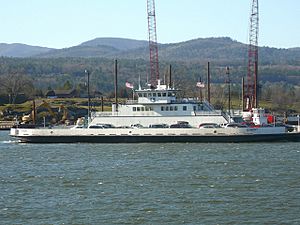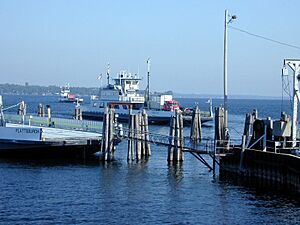Lake Champlain Transportation Company facts for kids
| Private Company | |
| Industry | Transportation |
| Founded | 1826; incorporated 1976 |
| Headquarters | Burlington, Vermont, United States |
|
Key people
|
Raymond Pecor III, President |
| Products | Ferry service, Sightseeing cruises |
The Lake Champlain Transportation Company (often called LCTC or LCT) is a company that operates ferries across Lake Champlain. These ferries connect the states of New York and Vermont. From 1976 to 2003, Raymond C. Pecor Jr. owned the company. He is still the chairman of its board. In 2003, he sold the company to his son, Raymond Pecor III.
Lake Champlain is a very large lake. It is the thirteenth-largest lake in the United States. The lake can be up to 12 miles wide and over 300 feet deep. Because it is so wide, there are no bridges across the main part of the lake. About one million people cross the lake by ferry every year.
Contents
Ferry Routes and Services
The Lake Champlain Transportation Company offers ferry services at different points. They also provide fun sightseeing cruises.
Main Ferry Routes
The company originally offered ferry services at three main locations. These routes helped people and vehicles cross the lake.
- Charlotte, Vermont to Essex, New York
- Burlington, Vermont to Port Kent, New York
- Grand Isle, Vermont to Plattsburgh, New York at Cumberland Head
All these routes use at least two ferries. These ferries are "double-ended," meaning they can move in either direction without turning around. They can carry large trucks, cars, bicycles, and people. They are designed for vehicles to drive on and off easily. Sometimes, if an engine has a problem, they can still operate using one end. For safety, luggage and vehicles on some ferries might be checked. Many people find these ferry rides very beautiful.
During the summer, the company also offers special dinner cruises. These cruises start from Burlington. They also have special trips to watch Fourth of July fireworks.
Charlotte to Essex Ferry
The Charlotte to Essex ferry runs all year round. However, it might stop if there is too much ice on the lake. This route became a year-round service in 1998. It has operated every winter since then, except for two.
Before the Champlain Bridge was built in the 1920s, this was the main way to cross the lake.
Burlington to Port Kent Ferry
The Burlington to Port Kent ferry crossed the widest part of the lake. This route did not operate in the winter. The trip usually took about one hour.
This ferry route last operated in 2019. It has not run since then.
Grand Isle to Plattsburgh Ferry
The Grand Isle to Plattsburgh ferry is an "ice-breaking" route. This means the ferries used here can break through ice. This route offers service 24 hours a day, all year round. The crossing on this route is very quick, taking about 12 minutes. In 2001, the company spoke out against a plan to build a bridge that would replace this ferry route.
Crown Point to Chimney Point Ferry
A temporary ferry service once operated between Crown Point, New York, and Chimney Point, Vermont. The Lake Champlain Transportation Company ran this ferry for free. The states of New York and Vermont paid for it. This service was needed because the old Champlain Bridge had structural problems and was removed. A new bridge was being built.
This temporary ferry crossing took about 20 minutes. It operated 24 hours a day. When the new Lake Champlain Bridge opened on November 7, 2011, this ferry service was no longer needed and stopped running.
Ferries of the LCTC
Ferries Currently in Use
The Lake Champlain Transportation Company uses several ferries today. Six of these vessels can operate in icy conditions.
- The Evans Wadhams Wolcott (built in 1988). This ferry was made to run in ice. It is often called the "EWW." Its name honors Lewis P. Evans Jr., Richard H. Wadhams, and James G. Wolcott. They were the founders of the modern company.
- The Governor George D. Aiken (built in 1975). It is named after a former governor of Vermont and U.S. Senator.
- The Grand Isle (built in 1953). This ferry was updated in 1995 and made 40 feet longer. It can now run in ice. It is named after a town in Vermont but operates on the Charlotte-Essex route.
- The Northern Lights (built in 2002). This vessel looks like the old steamboat Ticonderoga. It is used for public sightseeing and private cruises. These are offered under the name "Lake Champlain Cruises."
- The Plattsburgh (built in 1984). This ferry was built to run in ice. It is named after Plattsburgh, New York.
- The Valcour (built in 1947). This ferry was made from leftover materials from World War II. It is named after Valcour Island, where a famous battle took place. This was the last ferry built on Lake Champlain. It was constructed at the historic Shelburne Shipyard.
- The Vermont (built in 1992). This ferry was also built to run in ice.
- The Cumberland (built in 2000). This ferry was built to run in ice. It is named after Cumberland Head, where the Plattsburgh ferry dock is located.
- The Raymond C. Pecor Jr., (built in 2010). This ferry is named after Raymond Pecor Jr. He managed the company from 1976 to 2004. He is the father of Raymond Pecor III, the current president. Raymond Pecor Jr. also owns the Vermont Lake Monsters, a minor league baseball team.
Ferries No Longer in Use
Some ferries that the LCTC used in the past are no longer in service.
- The Adirondack
- This was the oldest double-ended ferryboat ever in service. It was built in 1913. It was named after the Adirondack Mountains.
- This ferry was taken apart for scrap in 2022.
- The Champlain
- This ferry was built in 1930. It also served as a charter cruise boat for large groups.
- This ferry was also taken apart for scrap in 2022.
- The Charlotte
- The Essex
- The Mount Marcy
History of Lake Champlain Ferries
From about 1820 to 1850, about five horse-powered ferries operated on Lake Champlain. These ferries used horses to power them across the water.
In 1983, a shipwreck was found in Lake Champlain. It was a horse-powered ferry from Burlington Bay. Horse-powered ferries were most popular in the 1830s and 1840s. By the 1850s, steamboats became common. This caused horse-powered ferries to quickly disappear.
Ice-Breaking on Lake Champlain
In winter, Lake Champlain sometimes freezes over. This makes it hard for ferries to operate on longer routes like Burlington-Port Kent. However, the Grand Isle-Cumberland Head route is shorter. Ferries on this route can keep a path open through the ice. This is important because many cars use this ferry. The ferries on this route are designed to break ice. Their hulls and propellers are made stronger to move through thin or broken ice. By running all the time, these ferries keep a clear path open throughout the winter.
In the past, ferries did not run all night. But in winter, a few trips were made during the night. This stopped the ice from freezing solid. Now, scheduled trips continue throughout the night.
Supporting the Community
The Lake Champlain Transportation Company is a big supporter of the Pecor Family Foundation. This foundation gives money to many charities. These include groups like the American Cancer Society and United Way. They also support schools like the University of Vermont and Champlain College.
See Also
- List of icebreakers
- Maritime Transportation Security Act
Images for kids







